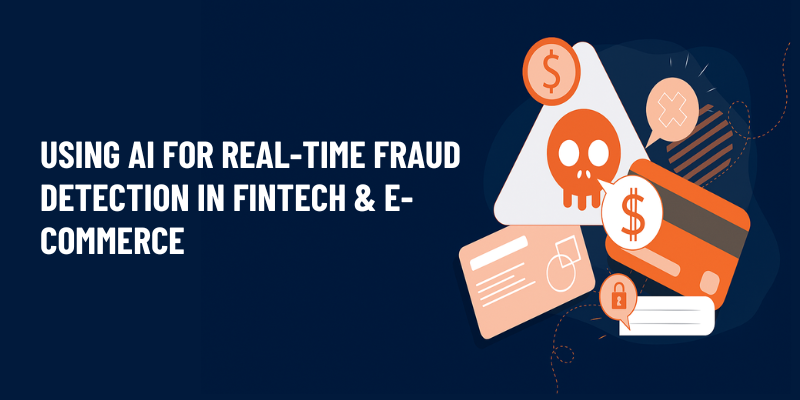Using AI for Real-Time Fraud Detection in FinTech & E-Commerce

Why the Future of Marketing Belongs to Full-Stack Marketers
July 30, 2025
The 8 Levels of Modern SEO: A Guide to Dominating the Digital Conversation
August 13, 2025In today’s fast-paced digital economy millions of transactions occur every second. While this speed offers great convenience for customers, it also opens the door for sophisticated fraudsters who operate at lightning speed. Whether it’s unauthorized credit card use, identity theft, or fraudulent chargebacks, FinTech companies and e-commerce platforms are becoming prime targets. As cybercriminals becoming more advanced, traditional rule-based fraud detection systems are no longer enough. To outsmart fraudsters, businesses are now turning to the power of Artificial Intelligence (AI) transforming fraud detection from a reactive task into a proactive, intelligent defense mechanism. By utilizing machine learning and deep learning, AI powered systems can analyze vast amounts of data in real time, identify subtle anomalies, and secure the digital ecosystem with a level of precision and speed that was previously impossible.
The Problem with Traditional Fraud Detection
Conventional fraud detection systems typically rely on rules-based approaches. For example, flagging transactions above a certain value or coming from unfamiliar locations. While useful, these static rules can’t adapt quickly to new fraud tactics or detect subtle patterns in massive datasets. Additionally, many legacy systems operate in batch mode, reviewing transactions only after they’ve been processed, that is when the damage is already done. In contrast, AI-powered solutions bring the advantages of speed, scalability, and adaptability, enabling real-time analysis that evolves alongside emerging fraud techniques.
How AI-Powered Systems Are Different
AI models are trained on massive datasets of historical transactions, learning to distinguish between legitimate and fraudulent behavior. They don’t just follow static rules, they learn to recognize complex, subtle patterns that are invisible to the human eye. This allows them to make informed decisions in real-time.
Here are some key ways AI is transforming fraud detection:
- Real-time Analysis: AI systems can process and analyze thousands of data in milliseconds. As a transaction is being initiated, the AI can assess a multitude of factors such as location, device type, purchase history, and even the time of day to calculate a risk score. If the score is high, the system can instantly block the transaction or request a secondary authentication step, like a one-time password (OTP) stopping threats before they cause damage.
- Behavioral Biometrics: Beyond simple data points, AI can analyze user behavior itself. Is the customer typing at their usual speed? Are their mouse movements and scrolling patterns normal? Sudden, uncharacteristic changes can be a strong indicator of an account takeover attempt, and AI can detect this and raise alerts without disrupting the customer’s experience.
- Adaptive Learning: Fraudsters are constantly changing their methods. The strength of a machine learning model is its ability to learn and adapt with changes. As new fraud patterns emerge, the model can be retrained with new data, continuously improving its accuracy and staying one step ahead of criminals. This is a stark contrast to rule-based systems, which require manual updates every time a new fraud scheme is discovered.
- Anomaly Detection: AI excels at identifying “anomalies,” or deviations from normal behavior. An unsupervised learning model can operate without pre-labeled training data, making it particularly effective at detecting previously unseen types of fraud. If a user suddenly logs in from a new country and attempts a large transfer, the system can immediately identify this as an outlier and flag it for review.
- Reduced False Positives: One major advantage of AI is its ability to understand individual user behavior. This allows it to accurately distinguish between legitimate and suspicious activity, leading to fewer false alarms. As a result, customers enjoy smoother transactions, and fraud teams can focus on real threats instead of chasing false leads.
Challenges and Ethical Considerations in AI-Powered Fraud Detection
While AI offers tremendous promise in the fight against fraud, its implementation also brings important challenges and ethical responsibilities that organizations must carefully manage.
1. Data Privacy Concerns
To detect fraud accurately, AI systems require access to large volumes of customer data such as transaction histories, device IDs, and behavioral patterns. In both e-commerce and FinTech, this often involves highly sensitive information. Businesses must prioritize data security and comply with privacy regulations like GDPR, CCPA, and other regional laws. Ensuring customer consent, secure storage, and transparent data usage policies is essential to maintaining trust and avoiding legal risks.
2. Algorithmic Bias
AI models are only as fair as the data they’re trained on. If historical data contains bias AI models may inadvertently learn and repeat existing biases. For example, certain regions, income brackets, or user behaviors may be unfairly flagged as high-risk based on outdated or skewed data. This can lead to discrimination in loan approvals, payment blocks, or transaction delays. E-commerce and FinTech companies must actively work to audit, refine, and diversify their training data to ensure fair and inclusive fraud detection.
3. The “Black Box” Problem
In financial and online retail environments, customers demand transparency, especially when a payment is declined or a transaction is flagged. However, deep learning models used in fraud detection often operate as “black boxes,” making it difficult to explain why a certain decision was made. This lack of clarity can hinder customer service, lead to regulatory challenges, and undermine trust. To address this, businesses are increasingly adopting Explainable AI (XAI) to provide clear reasoning behind AI-driven decisions, making systems more transparent and accountable.
Conclusion:
The future of fraud detection is undoubtedly AI-driven. By moving beyond static rules and embracing the dynamic, adaptive power of machine learning, deep learning, and behavioral biometrics, FinTech and e-commerce companies can not only protect themselves from financial loss but also build a more secure and trustworthy digital environment for their customers. The key to success will be a thoughtful, ethical approach that balances cutting-edge technology with strong oversight and human-in-the-loop validation.

